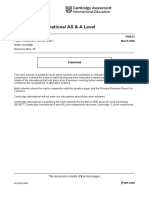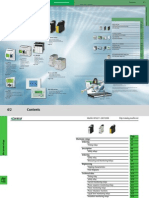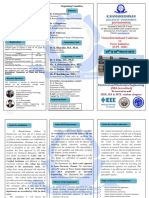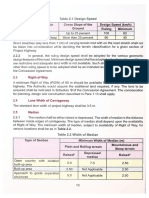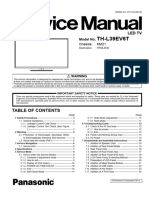Cambridge Assessment International Education: Chemistry 9701/34 May/June 2018
Cambridge Assessment International Education: Chemistry 9701/34 May/June 2018
Uploaded by
azadaland40Copyright:
Available Formats
Cambridge Assessment International Education: Chemistry 9701/34 May/June 2018
Cambridge Assessment International Education: Chemistry 9701/34 May/June 2018
Uploaded by
azadaland40Original Title
Copyright
Available Formats
Share this document
Did you find this document useful?
Is this content inappropriate?
Copyright:
Available Formats
Cambridge Assessment International Education: Chemistry 9701/34 May/June 2018
Cambridge Assessment International Education: Chemistry 9701/34 May/June 2018
Uploaded by
azadaland40Copyright:
Available Formats
Cambridge Assessment International Education
Cambridge International Advanced Subsidiary and Advanced Level
CHEMISTRY 9701/34
Paper 3 Advanced Practical Skills 2 May/June 2018
MARK SCHEME
Maximum Mark: 40
Published
This mark scheme is published as an aid to teachers and candidates, to indicate the requirements of the
examination. It shows the basis on which Examiners were instructed to award marks. It does not indicate the
details of the discussions that took place at an Examiners’ meeting before marking began, which would have
considered the acceptability of alternative answers.
Mark schemes should be read in conjunction with the question paper and the Principal Examiner Report for
Teachers.
Cambridge International will not enter into discussions about these mark schemes.
Cambridge International is publishing the mark schemes for the May/June 2018 series for most
Cambridge IGCSE™, Cambridge International A and AS Level and Cambridge Pre-U components, and
some Cambridge O Level components.
IGCSE™ is a registered trademark.
This document consists of 10 printed pages.
© UCLES 2018 [Turn over
9701/34 Cambridge International AS/A Level – Mark Scheme May/June 2018
PUBLISHED
Generic Marking Principles
These general marking principles must be applied by all examiners when marking candidate answers. They should be applied alongside the
specific content of the mark scheme or generic level descriptors for a question. Each question paper and mark scheme will also comply with these
marking principles.
GENERIC MARKING PRINCIPLE 1:
Marks must be awarded in line with:
• the specific content of the mark scheme or the generic level descriptors for the question
• the specific skills defined in the mark scheme or in the generic level descriptors for the question
• the standard of response required by a candidate as exemplified by the standardisation scripts.
GENERIC MARKING PRINCIPLE 2:
Marks awarded are always whole marks (not half marks, or other fractions).
GENERIC MARKING PRINCIPLE 3:
Marks must be awarded positively:
• marks are awarded for correct/valid answers, as defined in the mark scheme. However, credit is given for valid answers which go beyond the
scope of the syllabus and mark scheme, referring to your Team Leader as appropriate
• marks are awarded when candidates clearly demonstrate what they know and can do
• marks are not deducted for errors
• marks are not deducted for omissions
• answers should only be judged on the quality of spelling, punctuation and grammar when these features are specifically assessed by the
question as indicated by the mark scheme. The meaning, however, should be unambiguous.
GENERIC MARKING PRINCIPLE 4:
Rules must be applied consistently e.g. in situations where candidates have not followed instructions or in the application of generic level
descriptors.
© UCLES 2018 Page 2 of 10
9701/34 Cambridge International AS/A Level – Mark Scheme May/June 2018
PUBLISHED
GENERIC MARKING PRINCIPLE 5:
Marks should be awarded using the full range of marks defined in the mark scheme for the question (however; the use of the full mark range may
be limited according to the quality of the candidate responses seen).
GENERIC MARKING PRINCIPLE 6:
Marks awarded are based solely on the requirements as defined in the mark scheme. Marks should not be awarded with grade thresholds or
grade descriptors in mind.
© UCLES 2018 Page 3 of 10
9701/34 Cambridge International AS/A Level – Mark Scheme May/June 2018
PUBLISHED
Question Answer Marks
1(a) I Table(s) to show data for 5 experiments on pages 2, 3 and / or 4 1
• initial temperature (owtte)
• final temperature
• mean temperature
• time
• rate
II Headings unambiguous and units correct for all data recorded: (°C), / s, in s–1 1
III All thermometer readings recorded to .0 or .5 1
and
all times as integers.
IV Selects initial temperatures in experiments 3, 4 & 5 that are at least 5 °C apart from any other and none > 75 °C. 1
V All mean temperatures correctly calculated to 1 dp 1
VI All rates correctly calculated to 2─4 sf 1
Award VII if all rates increase with increase in temperature or all times decrease with increase in temperature 1
Award VIII from graph if all results give an increasing gradient. 1
© UCLES 2018 Page 4 of 10
9701/34 Cambridge International AS/A Level – Mark Scheme May/June 2018
PUBLISHED
Question Answer Marks
1(b) I Axes correctly labelled 1
Rate on y-axis and temperature on x-axis (average temperature must have been plotted)
Linear scales chosen so graph occupies more than half the available length for both axes including 15 °C on x-axis.
Points in 6 large squares on y-axis
and
y-axis must not go below 0
II All points from data recorded (minimum 4 experiments carried out) accurately plotted (within ½ small square) 1
Any point that is supposed to be on a line must be on the line, and any point that is supposed to be inside a small square
must not be on a boundary line.
III Line of best fit drawn 1
IV Curved line extrapolated to 15.0 °C 1
1(c) 2 construction lines correct to within a small square shown at 52.5 °C 1
Rate correctly read (from candidate’s construction line) to half a small square and 1
correctly calculates time to nearest second from 1000 / rate
© UCLES 2018 Page 5 of 10
9701/34 Cambridge International AS/A Level – Mark Scheme May/June 2018
PUBLISHED
Question Answer Marks
1(d) Rate of reaction increases with increase in temperature 1
or rate is proportional to temperature
Rate of rate of reaction increases because gradient increases with temperature / rate of reaction increases more / at a 1
greater rate than increase in temperature as gradient increases / graph is exponential / acceleration of rate with
temperature increase
1(e)(i) Correctly calculates 32.8 / 180(.0) = 0.182 / 0.1822 mol dm–3 1
and answer to 3 or 4 sf
1(e)(ii) Correctly uses n(glucose) = (e)(i) ÷ 40 (= 0.00455 / 0.00456 mol) 1
Correctly uses n(KMnO4) = ans × 2 / 5 (= 0.00182 mol) 1
Correctly uses V(KMnO4) = ans × 1000 / 0.01 (= 182 cm3) 1
or ans ÷ 0.01 (= 0.182 dm3)
Correct units required.
1(e)(iii) Allow terminal CHO oxidised to COOH, 1
terminal CH2OH oxidised to CHO or COOH
any CHOH oxidised to C = O
any combination of the above
1(f)(i) Correct expression 1
1 × 100 / time for Experiment 1 and answer to 2–4 sf
1(f)(ii) Identifies no anomaly as all points are near line of best fit 1
or
Identifies one anomaly as point is too far from line of best fit
If 2 or more anomalies, then the one furthest from the line must be selected.
or
Highest temperature experiment as shortest time so largest / large (%) error in timing
or
Lowest temperature experiment as difficult to judge the end point (owtte)
© UCLES 2018 Page 6 of 10
9701/34 Cambridge International AS/A Level – Mark Scheme May/June 2018
PUBLISHED
Question Answer Marks
1(g) Any two of 2
• Use thermostatically controlled water bath (to heat both reagents / keep reagents at const T).
• Take the temperature on initial mixing (and the temperature as soon as the mixture turns colourless and calculate
a mean T).
• Use more precisely calibrated thermometer (allow more precise but not more accurate or more sensitive) not ‘use
a digital thermometer’
• Use light sensor / colorimeter (to avoid subjective judgement of colour fade).
• Use (graduated) pipette / burette / measuring cylinders calibrated to greater precision (to measure volumes of FB 2
and FB 3).
© UCLES 2018 Page 7 of 10
9701/34 Cambridge International AS/A Level – Mark Scheme May/June 2018
PUBLISHED
Question Answer Marks
FB 4 = starch(aq); FB 5 = glucose(aq); FB 6 = sucrose(aq); FB 7 = CuSO4(aq); FB 8 = NaOH(aq)
2(a)(i) 3 asterisks (*) = 1 mark 3
test FB 4 FB 5 FB 6
+ I2 blue-black / black / dark no reaction / no no reaction / no
blue* change / yellow / brown* change / yellow / brown*
+ no reaction / no purple / pink / KMnO4 / MnO4─ no reaction / no
H+ / MnO4– change / (turns / remains) to colourless* change / (turns / remains)
purple / pink* purple / pink*
+ no reaction / no (blue / green to) brick no reaction / no
Sandell’s change / blue / green* red / orange / red- change / blue / green*
brown / orange-
brown / yellow-
brown / green-brown / brown
ppt*
© UCLES 2018 Page 8 of 10
9701/34 Cambridge International AS/A Level – Mark Scheme May/June 2018
PUBLISHED
Question Answer Marks
2(a)(ii) FB 4 = starch and FB 5 = aldehyde 1
2(a)(iii) Either 1
selects Tollens’ (reagent)
and
silver (mirror / ppt / solid) / black ppt / dark grey ppt
or
selects acidified potassium dichromate / H+ / K2Cr2O7, (warm)
and
orange to green solution
2(b)(i) 2 asterisks (*) = 1 mark 6
test FB 7 FB 8
+ Ag+ no reaction / no brown ppt * (ppt dissolves in excess is CON)
change / no ppt*
allow paler (blue)
+ Ba2+ white ppt* Either or
no ppt / no change / no (faint) white ppt*
reaction*
+ H+ Insoluble / no no change / no reaction* ppt soluble*
change / white ppt
(remains)*
+ I2 ppt in green-yellow- decolourises / solution paler (yellow)*
brown-grey range*
+ Fe2+ no reaction / no green ppt*
change* turns brown (at surface) / brown ppt*
+ FB 8 blue ppt *
© UCLES 2018 Page 9 of 10
9701/34 Cambridge International AS/A Level – Mark Scheme May/June 2018
PUBLISHED
Question Answer Marks
2(b)(ii) FB 7 cation Cu2+ / copper(II)* anion SO42– / sulfate* 2
FB 8 cation unknown* anion OH– / hydroxide*
2 asterisks (*) = 1 mark
2(b)(iii) Correct ions for precipitation reaction observed in (i) and correct product and no spectator ions 1
Equation balanced and correct state symbols 1
© UCLES 2018 Page 10 of 10
You might also like
- Range Rover Owners Handbook (2004)Document290 pagesRange Rover Owners Handbook (2004)mavioglu71% (7)
- PHSS Control Strategy White PaperDocument13 pagesPHSS Control Strategy White PaperAkuWilliams100% (1)
- Olympiad Sample Paper 2: Useful for Olympiad conducted at School, National & International levelsFrom EverandOlympiad Sample Paper 2: Useful for Olympiad conducted at School, National & International levelsRating: 5 out of 5 stars5/5 (4)
- Goldstein 13-14-2Document6 pagesGoldstein 13-14-2Meme DollNo ratings yet
- Osmosis Worksheet (30 PTS)Document2 pagesOsmosis Worksheet (30 PTS)RhynnieNo ratings yet
- Design of AbsorberDocument18 pagesDesign of AbsorberAdeel Ahmed100% (2)
- Cambridge Assessment International Education: Physics 9702/31 May/June 2018Document7 pagesCambridge Assessment International Education: Physics 9702/31 May/June 2018Lakhan VaishnavNo ratings yet
- Cambridge Assessment International Education: Physics 9702/32 May/June 2018Document7 pagesCambridge Assessment International Education: Physics 9702/32 May/June 2018xhtxsteveNo ratings yet
- Cambridge Assessment International Education: Biology 9700/31 May/June 2018Document7 pagesCambridge Assessment International Education: Biology 9700/31 May/June 2018shabanaNo ratings yet
- Cambridge Assessment International Education: Physics 9702/33 May/June 2018Document7 pagesCambridge Assessment International Education: Physics 9702/33 May/June 2018leon1973No ratings yet
- Cambridge Assessment International Education: Biology 9700/32 May/June 2018Document7 pagesCambridge Assessment International Education: Biology 9700/32 May/June 2018shabanaNo ratings yet
- Cambridge Assessment International Education: Physics 0625/51 May/June 2018Document8 pagesCambridge Assessment International Education: Physics 0625/51 May/June 2018Tao FanNo ratings yet
- Cambridge Assessment International Education: Biology 9700/34 May/June 2018Document7 pagesCambridge Assessment International Education: Biology 9700/34 May/June 2018shabanaNo ratings yet
- 0625 m18 Ms 62Document7 pages0625 m18 Ms 62Syed AshabNo ratings yet
- Cambridge Assessment International Education: Chemistry 9701/31 May/June 2018Document8 pagesCambridge Assessment International Education: Chemistry 9701/31 May/June 2018Kazi Ahnaf SaadNo ratings yet
- Cambridge Assessment International Education: Physics 0625/52 March 2018Document7 pagesCambridge Assessment International Education: Physics 0625/52 March 2018Tao FanNo ratings yet
- Cambridge Assessment International Education: Physics 5054/31 May/June 2018Document6 pagesCambridge Assessment International Education: Physics 5054/31 May/June 2018HAMZA QURESHINo ratings yet
- Cambridge Assessment International Education: Chemistry 0620/53 May/June 2018Document6 pagesCambridge Assessment International Education: Chemistry 0620/53 May/June 2018Aaa IiiNo ratings yet
- Cambridge Assessment International Education: This Document Consists of 7 Printed PagesDocument7 pagesCambridge Assessment International Education: This Document Consists of 7 Printed PagesshabanaNo ratings yet
- Cambridge Assessment International Education: Physics 0625/52 May/June 2018Document8 pagesCambridge Assessment International Education: Physics 0625/52 May/June 2018Tao FanNo ratings yet
- Cambridge Assessment International Education: Chemistry 9701/36 October/November 2018Document8 pagesCambridge Assessment International Education: Chemistry 9701/36 October/November 2018gmy101700No ratings yet
- Cambridge Assessment International Education: Physics 9702/33 March 2018Document7 pagesCambridge Assessment International Education: Physics 9702/33 March 2018Anshul ShahNo ratings yet
- Cambridge Assessment International Education: Biology 9700/35 October/November 2018Document7 pagesCambridge Assessment International Education: Biology 9700/35 October/November 2018smartvhotspotNo ratings yet
- Cambridge Assessment International Education: Chemistry 9701/33 May/June 2019Document9 pagesCambridge Assessment International Education: Chemistry 9701/33 May/June 2019ethanchia42069No ratings yet
- Grade:-AS Level: Cambridge Assessment International EducationDocument10 pagesGrade:-AS Level: Cambridge Assessment International EducationTarique MasoodNo ratings yet
- 0610 s18 Ms 62 PDFDocument9 pages0610 s18 Ms 62 PDFTesterNo ratings yet
- 9701_w24_ms_35Document9 pages9701_w24_ms_35For GamingNo ratings yet
- Cambridge Assessment International Education: Physics 9702/34 May/June 2018Document7 pagesCambridge Assessment International Education: Physics 9702/34 May/June 2018xhtxsteveNo ratings yet
- Cambridge Assessment International Education: Chemistry 0620/62 May/June 2018Document6 pagesCambridge Assessment International Education: Chemistry 0620/62 May/June 2018ahpungNo ratings yet
- Cambridge International AS & A Level: Chemistry 9701/33 March 2020Document10 pagesCambridge International AS & A Level: Chemistry 9701/33 March 2020kwabenaamehNo ratings yet
- November 2020 (v1) MSDocument12 pagesNovember 2020 (v1) MSgeraldinemambwere08No ratings yet
- Cambridge Assessment International Education: Computer Science 0478/21 May/June 2018Document11 pagesCambridge Assessment International Education: Computer Science 0478/21 May/June 2018Shenal PereraNo ratings yet
- Cambridge International AS & A Level: Chemistry 9701/33 March 2020Document10 pagesCambridge International AS & A Level: Chemistry 9701/33 March 2020Trang NguyenNo ratings yet
- 9701 MW ScriptDEF P34 MSDocument10 pages9701 MW ScriptDEF P34 MSLee NahyunNo ratings yet
- 9700 m18 Ms 33 PDFDocument6 pages9700 m18 Ms 33 PDFIG UnionNo ratings yet
- Cambridge Assessment International Education: Chemistry 9701/34 May/June 2019Document10 pagesCambridge Assessment International Education: Chemistry 9701/34 May/June 2019fahad0302042No ratings yet
- Cambridge Assessment International Education: Economics 2281/22 May/June 2018Document18 pagesCambridge Assessment International Education: Economics 2281/22 May/June 2018AdeenaNo ratings yet
- Cambridge Assessment International Education: Chemistry 0620/61 May/June 2018Document6 pagesCambridge Assessment International Education: Chemistry 0620/61 May/June 2018...No ratings yet
- Chemistry Igcse 0620 October 2023 Paper 6 Variant 3Document7 pagesChemistry Igcse 0620 October 2023 Paper 6 Variant 3sally.mansterlyNo ratings yet
- Cambridge Assessment International Education: Chemistry 0620/52 March 2018Document6 pagesCambridge Assessment International Education: Chemistry 0620/52 March 2018KHANNo ratings yet
- Cambridge Assessment International Education: Computer Science 0478/22 March 2018Document9 pagesCambridge Assessment International Education: Computer Science 0478/22 March 2018sugandha27062008No ratings yet
- Cambridge Assessment International Education: Mathematics 9709/62 May/June 2018Document16 pagesCambridge Assessment International Education: Mathematics 9709/62 May/June 2018Skynet LeNo ratings yet
- Cambridge Assessment International Education: Biology 9700/21 May/June 2018Document14 pagesCambridge Assessment International Education: Biology 9700/21 May/June 2018Ali RanaNo ratings yet
- Cambridge International AS & A Level: Chemistry 9701/31 October/November 2020Document12 pagesCambridge International AS & A Level: Chemistry 9701/31 October/November 2020goriirana17.08No ratings yet
- Cambridge Assessment International Education: Physics 0625/63 May/June 2019Document8 pagesCambridge Assessment International Education: Physics 0625/63 May/June 2019Hayaa KhanNo ratings yet
- 9702 w22 Ms 31 PDFDocument8 pages9702 w22 Ms 31 PDFsangdeepNo ratings yet
- Cambridge International AS & A Level: Biology 9700/33 March 2020Document8 pagesCambridge International AS & A Level: Biology 9700/33 March 2020Mohamed HNo ratings yet
- Cambridge Assessment International Education: Biology 0610/42 March 2018Document10 pagesCambridge Assessment International Education: Biology 0610/42 March 2018Imran MushtaqNo ratings yet
- Cambridge Assessment International Education: Computer Science 0478/11 May/June 2018Document12 pagesCambridge Assessment International Education: Computer Science 0478/11 May/June 2018Shenal PereraNo ratings yet
- June 2021 Mark Scheme Paper 31Document7 pagesJune 2021 Mark Scheme Paper 31Inocent AraebNo ratings yet
- 9701_w24_ms_33Document11 pages9701_w24_ms_33For GamingNo ratings yet
- Cambridge Assessment International Education: Chemistry 9701/31 October/November 2019Document8 pagesCambridge Assessment International Education: Chemistry 9701/31 October/November 2019princessdinah7No ratings yet
- Cambridge International AS & A Level: Physics 9702/34 May/June 2020Document9 pagesCambridge International AS & A Level: Physics 9702/34 May/June 2020Arthur WirjoNo ratings yet
- Cambridge Assessment International Education: Chemistry 0620/52 October/November 2018Document6 pagesCambridge Assessment International Education: Chemistry 0620/52 October/November 2018jonalsmithzNo ratings yet
- 9709 w18 Ms 32Document19 pages9709 w18 Ms 32John KagandaNo ratings yet
- Cambridge Assessment International Education: History 0470/12 March 2018Document92 pagesCambridge Assessment International Education: History 0470/12 March 2018Rhea AgrawalNo ratings yet
- Cambridge Assessment International Education: This Document Consists of 8 Printed PagesDocument8 pagesCambridge Assessment International Education: This Document Consists of 8 Printed PagesPrishaaNo ratings yet
- 0610 s18 Ms 63 PDFDocument8 pages0610 s18 Ms 63 PDFTesterNo ratings yet
- Cambridge Assessment International Education: Business 9609/31 October/November 2019Document19 pagesCambridge Assessment International Education: Business 9609/31 October/November 2019Danny DrinkwaterNo ratings yet
- Cambridge International AS & A Level: Physics 9702/31 May/June 2021Document8 pagesCambridge International AS & A Level: Physics 9702/31 May/June 2021Ting Kuon LingNo ratings yet
- 0478 m17 Ms 22Document5 pages0478 m17 Ms 22M.Hassan Bin AdeelNo ratings yet
- Cambridge Assessment International Education: Chemistry 9701/31 May/June 2019Document8 pagesCambridge Assessment International Education: Chemistry 9701/31 May/June 2019junjia.fang666No ratings yet
- Cambridge Assessment International Education: Mathematics 9709/41 May/June 2018Document10 pagesCambridge Assessment International Education: Mathematics 9709/41 May/June 2018Andrei CristescuNo ratings yet
- Cambridge Assessment International Education: Physics 9702/43 October/November 2018Document12 pagesCambridge Assessment International Education: Physics 9702/43 October/November 2018Muhammad AhmedNo ratings yet
- Economic and Financial Modelling with EViews: A Guide for Students and ProfessionalsFrom EverandEconomic and Financial Modelling with EViews: A Guide for Students and ProfessionalsNo ratings yet
- 3m Bumpon ProductsDocument8 pages3m Bumpon ProductslarconeNo ratings yet
- CAT 2022 Composite Score & Calls Predictor - AmiyaDocument74 pagesCAT 2022 Composite Score & Calls Predictor - AmiyasunNo ratings yet
- Elements of Curriculum DesignDocument6 pagesElements of Curriculum DesignMary Ann Suzette Anub100% (2)
- Reminiscence and Life Story Work: A Practice Guide by Faith GibsonDocument2 pagesReminiscence and Life Story Work: A Practice Guide by Faith GibsonAlguémNo ratings yet
- 1-3 Four Seasons CaseDocument5 pages1-3 Four Seasons Caseabhishek fanseNo ratings yet
- UNIT 3 Reference NotesDocument31 pagesUNIT 3 Reference NotesAI034 Kumar BNo ratings yet
- Core Earth Life Science q1 Module 2Document21 pagesCore Earth Life Science q1 Module 2Mari OpocNo ratings yet
- Kapitel 04 G OnlineDocument148 pagesKapitel 04 G OnlineJuan TamezNo ratings yet
- CommonLit _ Young Atlanta Artist on the Rise Through Social MediaDocument3 pagesCommonLit _ Young Atlanta Artist on the Rise Through Social MediabemeryNo ratings yet
- Krce Eee Icpi - 2021Document2 pagesKrce Eee Icpi - 2021mrpoopieNo ratings yet
- BS en 13173-2001 (2011)Document28 pagesBS en 13173-2001 (2011)Mostafa SarvariNo ratings yet
- ACR Project RealDocument20 pagesACR Project RealMaria Carmela PanganibanNo ratings yet
- IRC SP 84 2014 - Manual of Specifications & Standards For Four Laning of Highways Through PPPDocument2 pagesIRC SP 84 2014 - Manual of Specifications & Standards For Four Laning of Highways Through PPPvtsh100100% (2)
- Function Calling - OpenAI APIDocument5 pagesFunction Calling - OpenAI APINayebare DominiqueNo ratings yet
- Em Swedenborg The Economy of The Animal Kingdom 1740 1741 Two Volumes Augustus Clissold 1845 1847 The Swedenborg Scientific Association 1955 First PagesDocument338 pagesEm Swedenborg The Economy of The Animal Kingdom 1740 1741 Two Volumes Augustus Clissold 1845 1847 The Swedenborg Scientific Association 1955 First Pagesfrancis batt100% (1)
- Teori MotivasiDocument2 pagesTeori MotivasiAndrianus AtuNo ratings yet
- Slump Test Report PMMDocument7 pagesSlump Test Report PMMLuqman Yusof83% (12)
- ListDocument1 pageListAbyan FarrasNo ratings yet
- Moore (6) 2013 Introduction Psychology HearingDocument228 pagesMoore (6) 2013 Introduction Psychology HearinglimguopingNo ratings yet
- TH L39ev6tDocument77 pagesTH L39ev6tจิรศักดิ์ อิเล็กทรอนิกส์No ratings yet
- Membuat Reagen Kimia Di LaboratoriumpdfDocument13 pagesMembuat Reagen Kimia Di LaboratoriumpdfMuhammad ToriNo ratings yet
- Shivam BhadaniDocument1 pageShivam BhadaniSomesh VemuriNo ratings yet
- 0320-Fighter 4 - LoresDocument133 pages0320-Fighter 4 - LoresjanetranpigloveNo ratings yet
- Olympus TG-6 Settings Guide VideoDocument2 pagesOlympus TG-6 Settings Guide VideoFernando IbáñezNo ratings yet
- Lifestyle Electrics and Fault Finding - A - XH00212Document18 pagesLifestyle Electrics and Fault Finding - A - XH00212Coil98No ratings yet














































